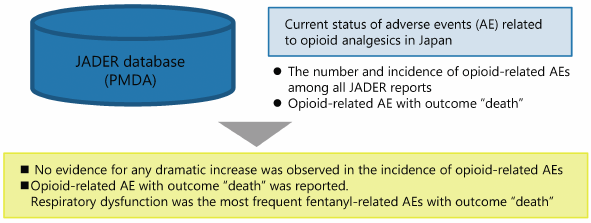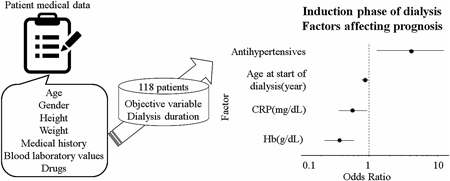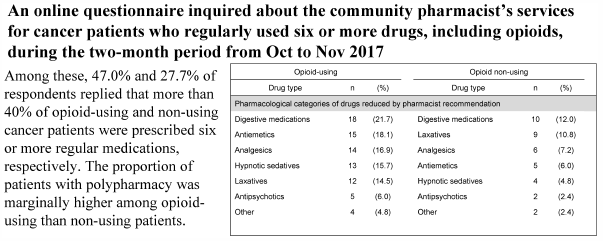- 著者
- Yoshihiro Uesawa Shigeru Hishinuma Masaru Shoji
- 出版者
- (公社)日本薬理学会
- 雑誌
- Journal of Pharmacological Sciences (ISSN:13478613)
- 巻号頁・発行日
- vol.124, no.2, pp.160-168, 2014-02-20 (Released:2014-02-19)
- 参考文献数
- 28
- 被引用文献数
- 3 6
There is argument whether non-sedative properties of histamine H1–receptor antagonists (antihistamines) are determined by their active extrusions from the brain via P-glycoprotein or their restricted penetration through the blood-brain barrier. We have reported that sedative and non-sedative antihistamines can be well discriminated by measuring changes in their binding to H1 receptors upon receptor internalization in intact cells, which depends on their membrane-penetrating ability. In this study, molecular determinants responsible for sedative and non-sedative properties of antihistamines were evaluated by quantitative structure-activity relationship (QSAR) analyses. Multiple regression analyses were applied to construct a QSAR model, taking internalization-mediated changes in the binding of antihistamines as objective variables and their structural descriptors as explanatory variables. The multiple regression model was successfully constructed with two explanatory variables, i.e., lipophilicity of the compounds at physiological pH (logD) and mean information content on the distance degree equality (IDDE) (r2 = 0.753). The constructed model discriminated between sedative and non-sedative antihistamines with 94% accuracy for external validation. These results suggest that logD and IDDE concerning lipophilicity and molecular shapes of compounds, respectively, predominantly determine the membrane-penetrating ability of antihistamines for their side effects on the central nervous system.
- 著者
- Ryuichiro Suzuki Yoshihiro Uesawa Yoshihito Okada Takumi Horikawa Yui Okabe Masaki Aburada Kunio Takahashi Kaoru Kinoshita
- 出版者
- The Pharmaceutical Society of Japan
- 雑誌
- Chemical and Pharmaceutical Bulletin (ISSN:00092363)
- 巻号頁・発行日
- vol.69, no.2, pp.199-202, 2021-02-01 (Released:2021-02-01)
- 参考文献数
- 11
The 13C-NMR spectral data for the 15-carbon flavonoid skeleton in eleven methoxyflavones isolated from Kaempferia parviflora (Zingiberaceae) were processed by principal component analysis (PCA). Based on the PCA score plots, the methoxyflavones were categorized into three groups according to their structural features. The cytotoxicities of the methoxyflavones toward 3T3-L1 murine preadipocyte cells were evaluated by 3-(4,5-dimethylthiazole-2-yl)-5-(3-carboxymethoxyphenyl)-2-(4-sulfophenyl)-2H-tetrazolium (MTT) assay and found to differ according to structure. The relationship between the 13C-NMR chemical shifts of the methoxyflavones and their cytotoxicities was investigated using Pearson’s correlation analysis. The 13C-NMR signal at C-10, a quaternary carbon, was correlated with cytotoxicity. Based on these results, a structural design which lowers the 13C-NMR chemical shift at C-10 would be important for the development of cytotoxic compounds. Although quantitative structure–activity and structure–property relationships are well established paradigms for predicting trends among a series of compounds, quantitative property–activity relationships have been relatively unstudied. This approach offers a new strategy for directing structure–activity relationship research.
- 著者
- Yukio Suga Mayako Uchida Shinya Suzuki Hideki Sugawara Kazuhiro Torigoe Akihiko Futamura Yoshihiro Uesawa Takayuki Nakagawa Hisamitsu Takase
- 出版者
- The Pharmaceutical Society of Japan
- 雑誌
- Biological and Pharmaceutical Bulletin (ISSN:09186158)
- 巻号頁・発行日
- vol.42, no.5, pp.801-806, 2019-05-01 (Released:2019-05-01)
- 参考文献数
- 24
- 被引用文献数
- 10
Opioid analgesics have greatly contributed to the advancement of pain management. However, although opioids have been appropriately used in Japan, they rarely induce serious adverse events, such as respiratory depression. The present study aimed to investigate the temporal changes in the occurrence of opioid-related adverse events and deaths between 2004 and 2017 in Japan using the Japanese Adverse Drug Event Report (JADER) database. We analyzed the following points using data extracted from JADER website: 1) temporal changes in the number and proportion of opioid-related adverse event reports; 2) temporal changes in the number of morphine-, oxycodone-, and fentanyl-related adverse event reports per annual consumption; and 3) cases in which the reported outcome following opioid-related adverse events was death. Our results showed no dramatic changes in the overall incidence of opioid-related adverse events, despite the temporal changes in the annual consumption and shared component of each opioid during the survey period. However, the number and rate of fentanyl-related adverse events and their outcome “death” increased since 2010, being the highest among all adverse event including those related to morphine and oxycodone. Outcome “death” by fentanyl-related adverse events was caused mainly due to respiratory depression. These findings suggest that, although opioid-related adverse events can be controlled through proper monitoring and management by medical personnel in Japan, extra caution should be continuously paid for the rare but serious fentanyl-induced adverse events.
- 著者
- Kousuke Nishikiori Kentaro Tanaka Takashi Ozawa Yoshihiro Uesawa
- 出版者
- The Pharmaceutical Society of Japan
- 雑誌
- Biological and Pharmaceutical Bulletin (ISSN:09186158)
- 巻号頁・発行日
- vol.46, no.1, pp.19-25, 2023-01-01 (Released:2023-01-01)
- 参考文献数
- 29
Various factors affect the prognosis of dialysis patients. Analysis of the drugs used and clinical and demographic characteristics of the patient at the time of dialysis initiation is a useful means of estimating prognosis. In this study, we investigated the drugs used by dialysis patients during the induction phase of dialysis and performed a detailed analysis of variables predictive of prognosis. Patients who underwent dialysis between June 1998 and January 2019 and died during this period were included in the study (n = 118). The induction phase of dialysis was defined as the first month after dialysis began. Dialysis duration was defined as the time between dialysis initiation and death. A univariate regression analysis was performed, with dialysis duration as the objective variable and the drugs used during the induction phase of dialysis, blood laboratory values, age at start of dialysis, sex, body height, body weight, medical history and cause of death as the explanatory variables. In addition, multiple logistic regression analysis with stepwise variable selection of significant factors was performed to determine the factors related to dialysis duration. Antihypertensives, hemoglobin (Hb), and age at start of dialysis were found to have significant effects on dialysis duration. It was posited that antihypertensives prolong dialysis duration, thereby improving life expectancy. The regression model developed allowed estimation of prognosis based on the drugs used during the induction phase of dialysis and patient characteristics. These findings may be used to improve drug adherence in dialysis patients and guide physicians in their treatment.
- 著者
- Shinya Suzuki Mayako Uchida Yukio Suga Hideki Sugawara Hideya Kokubun Yoshihiro Uesawa Takayuki Nakagawa Hisamitsu Takase
- 出版者
- The Pharmaceutical Society of Japan
- 雑誌
- Biological and Pharmaceutical Bulletin (ISSN:09186158)
- 巻号頁・発行日
- vol.42, no.7, pp.1164-1171, 2019-07-01 (Released:2019-07-01)
- 参考文献数
- 40
- 被引用文献数
- 2 12
No nationwide study on polypharmacy in palliative care among Japanese community pharmacies has yet been conducted. We conducted an online questionnaire survey for community pharmacist members of The Japanese Society for Pharmaceutical Palliative Care and Sciences regarding their contributions to cancer patients who regularly used six or more drugs, including opioids, in service during the two-month period from October to November 2017. Of 579 community pharmacists, 83 responded to the survey (14.3%). Among them, 47.0 and 27.7% of respondents replied that more than 40% of opioid-using and non-using cancer patients were prescribed six or more regular medications, respectively. The proportion of patients with polypharmacy was marginally higher among opioid-using than non-using patients. Additionally, 31.3 and 22.9% of respondents replied that a low or moderate rate of opioid-using and non-using patients with polypharmacy received inappropriate prescriptions, respectively, including “unnecessary medications,” “adverse drug reactions” and “duplication of pharmacological effect.” The proportion of patients who received inappropriate prescriptions was significantly higher among opioid-using than non-using patients. Furthermore, 37.3 and 19.3% of respondents replied that pharmacist’s recommendations contributed to drug reduction in opioid-using and non-using patients with polypharmacy who received inappropriate prescriptions, respectively. The responders with higher confidence in palliative care showed more success rate for reducing inappropriate medications. Our findings suggest that opioid use can be associated with an increased risk of polypharmacy in cancer patients, and that recommendations by a population of community pharmacists can reduce inappropriate medications and improve adverse drug reactions in both opioid-using and non-using cancer patients with polypharmacy.



